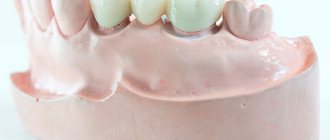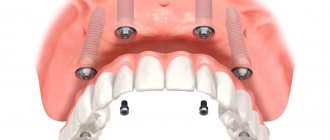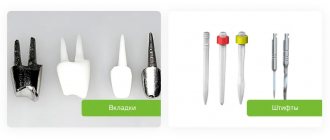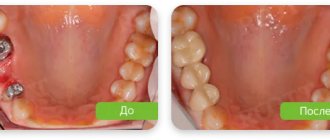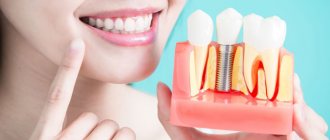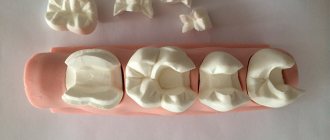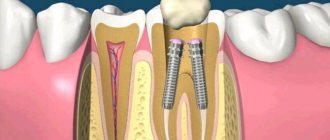Dental bridge - this is what people most often call dental bridges used by dentists to restore teeth when several units in a row are missing in a row. Dental bridges come in many different types, are made from different materials, and each type of structure has its own characteristics and advantages. Naturally, the price of different types of dental bridges will also differ.
In this article, we will tell you in detail about dental bridges: we will describe in detail the indications for their use, consider the types of dental bridges, the main characteristics, and also indicate approximate prices for production and installation in Moscow.
Indications for installation of dental bridges
Dental bridges are used to restore lost teeth, but not with single defects in the dentition, but when two, three or four teeth are missing. Bridges are applicable for the restoration of chewing and anterior dental units and effectively restore both the aesthetics of the dentition and all important functions of the teeth.
IMPORTANT: Installation of a dental bridge requires healthy supporting teeth. If the patient does not have strong teeth or has complete edentia (toothless jaw), the doctor may recommend either a removable denture or implantation followed by prosthetics with a conditionally removable orthopedic design. Implantation can be a good solution if the patient does not want to grind down healthy teeth for a bridge.
Prevention of crown loss
Once you have a crown installed, we recommend making sure it lasts a long time. To do this, you need to remember and follow simple rules.
- Forget about sticky candies, chewing gum, the habit of biting your nails, the tip of a pencil or pen.
- Brush your teeth regularly. If you haven't used brushes or an irrigator yet, now is the time. Also, don't forget about mouthwash.
- Monitor the condition of the crown. If even small defects are detected, it is recommended to consult a doctor.
- Once every six months, come for a check-up with an orthopedic dentist and do professional oral hygiene.
The loss of a crown causes great inconvenience. If this happens, you should immediately contact your dentist.
What a dental bridge looks like: description of design features
A dental bridge is a fixed prosthesis attached to supporting teeth and used to eliminate multiple edentia (the absence of several teeth in a row). The main elements of a dental bridge are artificial teeth and fasteners, with the help of which the prosthesis will be firmly fixed in the oral cavity.
Attachments for dental bridges can be in the form of:
Dental crowns placed on abutment teeth
Tabs
Clammers
Sometimes the design of a dental bridge also includes an additional element - a part designed to imitate a section of gum. Externally, the prosthesis resembles a bridge – that’s why it got its name.
The intermediate part of the dental bridge may have a different mechanism of connection with the soft tissues of the oral cavity:
- Flushing connection. In this case, a small space remains between the dental bridge and the soft tissues of the mouth, which ensures free passage of food under the denture, and therefore easier care for it;
- Tangent connection. With this type of connection, one side of the bridge will touch the gums, and such prostheses are especially relevant in the restoration of teeth included in the smile zone. They provide better aesthetics, are easy to use, and do not interfere with normal diction;
- Saddle-shaped. With this connection, the bridge connects to the soft tissues of the mouth as tightly as possible.
The type of dental bridge design is selected at the stage of planning prosthetics and together with the doctor leading the treatment!
Work examples
All works
Bridge prosthetics with metal-ceramic crowns
Manufacturing of metal-ceramic fixed bridge prosthesis
All works
Sign up for a consultation
three ROOTT specialists + diagnostics as a gift
Types of dental bridges
At the very beginning of the material, we mentioned that there are quite a large number of different types of dental bridges. The classification of bridges is carried out both according to the material of manufacture and the production technology.
Based on the first feature, the following types of dental bridges are distinguished:
Metal
Metal-ceramic
Ceramic
Zirconium
Plastic
Based on production technology, the following dental bridges are distinguished:
- Adhesive. It is most often used when only one tooth needs to be restored with a bridge. Such a prosthesis has a base - a fiberglass arch on which the artificial tooth is located;
- Stamped dental bridges are several dental crowns welded into a single structure;
- Cast dental bridges are the most durable denture option.
The material and manufacturing technology of a dental bridge will determine its cost and also its main performance characteristics, and below we will look at the main types of bridges, their features, pros and cons.
But first, let’s answer a question that patients often ask orthodontists – which is better, a dental bridge or implants?
How to remove a movable prosthesis, and what will happen to it next
What does a dentist do when a bridge becomes loose? Here, further treatment tactics can be “suggested” by an x-ray examination. But, as a rule, the bridge has to be removed. Removal is carried out using an ultrasonic scaler (which crumbles the cement inside). Crown and bridge removers are also used - for example, a Kopp apparatus or an automatic micromotor Anthogyr Safe Relax with strings (cables) and hooks. Once the deficiencies are corrected, the old prosthesis can be fixed back in place.
If it is impossible to remove the bridge without damage, the doctor will use special scissors or crown-cutting forceps - after which a new prosthesis will need to be made.
Which is better - a dental bridge or an implant?
Here we need to make an important note - prosthetics can be carried out without implants, but implantation necessarily involves the stage of prosthetics. Of course, implantation of implants will increase the final cost of treatment, however, when installing a prosthesis on implants, you will not have to grind down healthy teeth, in addition, the dental bridge will be fixed as firmly as possible in the oral cavity and this increases the comfort of its use, as well as the useful life of the prosthesis.
But of course, the patient and the doctor must decide how to restore teeth in a specific clinical case. For example, if examination and diagnostics reveal absolute contraindications to implantation, then lost teeth will have to be restored using classic prosthetics and the installation of a dental bridge on the supporting teeth.
Prices
Free online consultation with a dentist
| Service | Price |
| Installation of a complete metal-ceramic bridge prosthesis on one-stage implants of the ROOTT system on a metal frame, 1 jaw, cemented fixation | from 210,000 rub. from 250,000 rub. promotion |
| Installation of a complete metal-ceramic bridge prosthesis on one-stage implants of the ROOTT multi-unit system with screw fixation, 1 jaw, metal frame | from 230,000 rub. from 270,000 rub. promotion |
Consultation and diagnostics are free!
All prices Promotions
Metal dental bridges: pros, cons
Metal dental bridges can be called an outdated type of bridge prosthesis - they are almost never used in modern dental prosthetics, because the number of their disadvantages significantly outweighs the number of advantages. Dental bridges made of metals and their alloys are too heavy and bulky; their installation causes increased wear and tear on healthy teeth.
In addition, metal dental bridges are not highly aesthetic; when wearing them, a person may constantly feel an unpleasant and pronounced metallic taste in the mouth. The risk of an allergic reaction cannot be excluded. If we talk about the advantages of metal bridges, there are only two of them - maximum strength and low price. Of all types of metal dental bridges, solid dentures will have the highest reliability and durability.
Thanks to casting production technology, such dental bridges have a long service life and are able to flawlessly withstand constant and heavy loads. Dental bridges of this type are recommended for installation in patients with deformation of facial features caused by atrophy of the jaw bone tissue.
Metal dental bridges can be made from different metals and their alloys, including precious metals. Typically, the raw material for the production of metal dental bridges is cobalt-chrome alloy. But gold can also be used. Then the price of the prosthesis will increase, but neither its aesthetics nor the degree of comfort in use will improve. If prosthetics are carried out in the area of the front teeth, then dental bridges made of metal ceramics and ceramics can be a much more successful solution; if you need to restore chewing teeth, you can opt for the strongest bridges made of zirconium.
How much does a metal dental bridge cost? The answer to this question will depend on the technology of its production, as well as on the number of crowns in the structure, and the type of metal used to make the prosthesis. For example, if ordinary metal is used and a bridge is made for two dental units using casting technology, the cost of the prosthesis will range from 8 to 9 thousand rubles.
What does the cost consist of?
Our Center provides a case payment system
The implant installation case includes:
- local anesthesia;
- cost of the Nobel Biocare implant and its installation;
- consumables and superstructures;
- applying and removing sutures;
- control CT diagnostics after surgery.
The case for installing a bridge includes:
- taking impressions;
- production of prosthesis;
- fitting and fixation of the structure.
Paid separately:
- Diagnostic case before implantation - the cost depends on the necessary studies.
- Osteoplastic surgery if necessary - the price is calculated depending on the type of bone augmentation and the duration of the defect.
- Sedation - calculated for each hour spent in medicated sleep. Usually 1 hour is enough to install 2-3 implants.
The total cost of bridge prosthetics on implants is formed taking into account:
- length of the defect;
- type and number of implants;
- number of crowns in the structure;
- the need for osteoplasty;
- use of sedation.
Plastic dental bridges
The main advantage of a plastic dental bridge is its low price. It seems attractive to many people who want to restore lost teeth. However, before making a choice in favor of a budget dental bridge made of plastic, it is worth considering its disadvantages. And there are quite a lot of them. Among the disadvantages of plastic bridges:
- Low aesthetics. Artificial teeth made of plastic do not have the same beautiful natural shine as natural human teeth;
- Fragility. Dental bridges made of plastic easily break and are damaged by stress, but they cannot be restored - the broken element will have to be replaced, which implies new costs for prosthetics;
- Risks of allergic reactions;
- Over time, a plastic bridge will lose its visual appeal, since the plastic can darken under the influence of various factors. In addition, plastic wears out quite quickly. On average, plastic dentures will have to be replaced every 3-5 years.
Due to the listed disadvantages of plastic bridges, it is better to initially plan more expensive prosthetics using dental bridges made of metal-ceramics, ceramics and zirconium.
How much does dismantling cost?
The price for the service of removing an orthopedic device consists of the material from which it is made, the number of crowns to be removed and the method chosen by the doctor to remove it. How much does it cost to remove a fixed prosthesis? On average, the cost ranges from 800 to 3,000 rubles. And, as a rule, it is included in the total amount for subsequent treatment and preparation for prosthetics, or more precisely, re-prosthetics.
Metal-ceramic dental bridges: optimal price-quality ratio
Metal-ceramic dentures are quite in demand among patients and this is not surprising, because they are not inferior in strength to metal dental bridges, but at the same time have a much more aesthetic appearance. A metal-ceramic bridge achieves high aesthetics due to the fact that its crowns are covered with a layer of ceramic mass. Layer-by-layer application of ceramics onto a metal base allows you to obtain artificial teeth with the same shade as healthy teeth.
IMPORTANT: Despite the good aesthetics, dentists do not recommend choosing metal-ceramic dental bridges for dental prosthetics in the smile area. The fact is that the metal base of such a prosthesis can be quite noticeably visible through the ceramics. To restore the front teeth, it is best to use metal-free dental bridges that have the most natural and aesthetic appearance.
A metal-ceramic dental bridge can be placed both on abutment teeth and on implants. The price of the bridge will depend on the manufacturing technology and the number of units being restored. The average cost of a metal-ceramic bridge for two dental units is 16,000 rubles.
Unfortunately, it is not always possible to place a metal-ceramic dental bridge on a patient. Bridges made from this material cannot be used if:
- Advanced periodontal diseases;
- For some malocclusion pathologies. If malocclusion is detected, orthodontic treatment is required before installing a metal-ceramic dental bridge;
- Low natural crown of teeth.
Contraindications to the installation of metal-ceramic bridges are identified at the first stage of prosthetics, during which the patient undergoes examination and diagnosis.
What materials are they made of?
Dentures are manufactured in the Center’s own dental laboratory, you can choose the appropriate option to suit your taste and budget
- Metal-ceramic The base of the crowns is a metal alloy, the top is covered with ceramic mass. Relatively inexpensive, yet durable and quite aesthetic. The main disadvantage of metal ceramics is the ability to oxidize and cause a bluish outline to appear on the gums over time. Service life - 15 years or more .
- Zirconium Can be all-zirconium or coated with ceramics. They can withstand any load, do not deform, and retain their original appearance. Identical to natural teeth, the shade is selected individually. More expensive than metal-ceramic ones, but last longer. Service life - 25 years or more.
We offer patients the most profitable and practical methods, so we reserve the advantage for metal-free structures. In our Center, dental bridges are created in our own digital production using Zirkonzahn Schule technology or at the PROCERA (Nobel Biocare) plant in Sweden.
Ceramic dental bridges
Ceramic dental bridges are the best choice if you need to restore the front teeth that fall into the smile area. Dental ceramics is a material that has transparency and light transmission similar to natural tooth enamel, so dentures made from it have the most natural appearance; they are very difficult to distinguish from natural teeth. However, in terms of strength, ceramic bridges will, of course, be inferior to prostheses made of metal and metal-ceramics. The price for a ceramic bridge of 2 units is from 20 thousand rubles.
If, as a result of prosthetics, you want to get both high strength and aesthetics from the prosthesis, then it is worth considering the option of installing a dental bridge made of zirconium dioxide. This material has been used in dentistry relatively recently, and few patients have heard of it. Dental bridges made from high-quality zirconium dioxide are as attractive as ceramic products, and as reliable as metal structures. Moreover, zirconium is such a durable material that it can be used to make a bridge up to 6 dental units long! Another advantage of zirconium dental bridges is their durability - such a prosthesis can serve you flawlessly for 15-20 years! A zirconium bridge will cost more than a ceramic one - about 30,000 rubles per structure to restore 2 teeth.
IMPORTANT: The price of bridges will be influenced by production technology. The most modern technology for manufacturing dental bridges is CAD/CAM, which involves computer modeling of the prosthesis and its subsequent production using special milling equipment. The technology makes it possible to do without human intervention and, therefore, to avoid inaccuracies and errors. The finished prosthesis has high anatomical accuracy, which increases both the comfort of its use and the useful life of the dental bridge.
Adhesive dental bridges: what are they and when are they used?
Adhesive dental bridges can be attached to abutment teeth without first grinding them down. For this purpose, special beams, fiberglass tape or wing-shaped fasteners are used. Adhesive dental bridges are used exclusively for the restoration of anterior teeth, but they are not used to restore chewing units, because such prostheses do not have the required degree of strength.
The advantages of adhesive dental bridges include the following qualities:
- They allow you to carry out the restoration process as quickly as possible;
- They do not require depulping or preliminary grinding of healthy teeth;
- Such bridges have good aesthetics;
- An adhesive bridge does not require complex maintenance and can be easily restored if necessary;
- The price of prosthetics will be lower than when using bridges made of ceramics, metal-ceramics and zirconium.
However, adhesive dental bridges also have a significant number of disadvantages. In particular, it is worth knowing that they are not distinguished by either high strength or durability. On average, such a prosthesis will have to be changed every 3-4 years. In addition, with adhesive prosthetics, the artificial tooth is built up above the gum, which ultimately leads to atrophy of the jaw bone tissue in the area of the defect.
Concluding the review of the main types of dentures, let’s say that the choice of a specific type of denture should definitely be made together with your doctor. The specialist will take into account the particularities of the clinical case and contraindications and will be able to offer you those options for dental bridges that can solve your problem and suit you in terms of characteristics and price.
How dental bridges are installed: a detailed overview of the main stages of prosthetics
Dental bridge prosthetics begins with examination and diagnosis. This is a very important stage, as it allows you to eliminate possible contraindications, as well as select the optimal type of dental bridge for a particular patient. At the first stage of treatment, the doctor will examine the oral cavity, you will also be referred to an X-ray of the jaw, and may also be prescribed some general tests. Based on the information collected, a treatment plan is drawn up.
The further process of installing a dental bridge will involve the following steps:
1. Preparation of the oral cavity for prosthetics. In order for the installed dental bridge to last for a long time, it is extremely important that the patient’s mouth is free of diseased teeth, inflamed gums, tartar and plaque. Therefore, before prosthetics, it is necessary to treat caries, as well as sanitation of the oral cavity, during which the teeth are thoroughly cleaned of hard and soft dental deposits.
2. Next, teeth are prepared for the installation of a dental bridge. They are subjected to grinding and sometimes depulping.
Depulpation - this term in dentistry refers to the procedure for removing the dental nerve. Why is it needed before installing a dental bridge? The fact is that when grinding some teeth, there is a possibility of overheating of the pulp, which can lead to the development of pulpitis in the future. Therefore, sometimes a decision is made to pre-depulpate teeth before prosthetics with a dental bridge or crown.
3. The doctor takes impressions of the ground teeth, which are sent to the laboratory and where, based on them, first a computer model of the dental bridge is made, and then the prosthesis itself. When the prosthesis is ready, the patient is invited to try it on.
4. If during the fitting of the dental bridge no inaccuracies in its manufacture are revealed, the patient is satisfied with the prosthesis - it is fixed in the oral cavity using special dental cement. After installing a dental bridge, the dentist gives the patient detailed advice on caring for the oral cavity and dentures.
FAQ
There are many questions on the Internet that concern people who are faced with the need to dismantle orthopedic structures. Let's look at the most popular ones.
Is it possible to remove a permanent crown?
Undoubtedly. And this is far from the most difficult manipulation in the dentist’s chair. But it requires professionalism and skill from the doctor. For this purpose, today clinics most often use the Coppa crown remover (push method), Coronaflex (compressed air exposure) and ultrasound - that is, all the methods listed in the article above.
How is a dental bridge removed?
To dismantle the bridge structure, the doctor needs to carefully examine the patient’s oral cavity and decide on the method of removing it. Is it painful to remove a dental bridge? No. With the help of an ultrasonic scaler, the decementing process occurs quickly and without any pain. However, it all depends on the individual characteristics of the particular patient and pain threshold. If you feel any discomfort, you can always ask your doctor to apply anesthesia.
%akc72%
Is it painful to remove the structure?
Is it possible to quickly remove an artificial device from a tooth? Does it hurt? It all depends on the professionalism of the orthopedist and the chosen method of extraction. So, if the tooth has not previously hurt or the structure has not been loosened, the latter can be removed quite quickly and painlessly. If the most cost-effective removal method is chosen or it is important to preserve the integrity of the crown, the procedure may be accompanied by discomfort. But the patient definitely won’t have to suffer. If pain appears, the doctor will give an injection with an anesthetic.
Can I remove the product myself?
Often a tooth covered with a crown manifests itself as anxiety quite unexpectedly. Moreover, the degree of pain can be very high. Such that a person, under the influence of impulses, loses all common sense and begins to try to get rid of the prosthesis right at home. However, it will be difficult to dismantle it correctly yourself. Yes, and it's not safe.
However, there are only 2 exceptions to this rule:
- the orthopedic product has become loose/comes off entirely with its cement base,
- the structure has fallen apart and its fragments need to be removed from the mouth.
In any case, in order to avoid complications after self-removal of a fallen prosthesis or part of it, it is important to see your dentist as soon as possible.
Can complications occur after installing a dental bridge?
Complications after installing a dental bridge are possible and they can arise both due to the doctor’s mistakes and the patient’s fault, for example, due to failure to follow the recommendations of a specialist in caring for the oral cavity and prosthesis. The most common types of complications are:
1. Inflammation of periodontal tissues after the installation of a bridge. The inflammatory process may occur due to the fact that the bridge design was chosen incorrectly or the patient insisted on installing exactly this type of prosthesis. To avoid such a complication, you should listen to the opinion of a specialist when choosing a dental bridge for prosthetics!
2. Pain when chewing food. This phenomenon after the installation of a dental bridge occurs due to errors in the production of the prosthesis. If you notice discomfort when eating, and it does not go away within a few days, contact the clinic immediately. Inaccuracies in the manufacture of the prosthesis need to be corrected not only because such a bridge is inconvenient to use, but they can lead to rapid destruction of the supporting teeth.
3. Pain in the teeth under the crowns of the installed bridge. This complication can manifest itself due to poor oral hygiene and poor quality of the prosthesis. If the bridge was made with inaccuracies, the crowns will not fit tightly to the supporting teeth, which means that pathogenic microorganisms can easily get into them, which will cause caries and pain in the teeth. In this case, you definitely need to visit the dentist so that the doctor removes the denture and treats caries.
4. Development of pulpitis. This complication occurs when the supporting teeth are improperly prepared for the installation of a dental bridge. If, when grinding a tooth, the doctor allows its tissues and pulp to overheat, an inflammatory process may develop in the future.
These are not all the types of complications that can manifest themselves after installing a dental bridge if you do not follow the recommendations of your doctor or undergo treatment in a bad clinic that does not seek to treat patients, but to make money from them. Therefore, always carefully choose dentistry for your treatment!
Causes of structural instability
If the dental bridge is wobbly immediately after installation, then there may be 2 options - either a full diagnosis was not carried out (and the bridge could not be installed at all), or prosthetics1 occurred due to errors on the part of the doctor. Considering the last option, we can highlight the following reasons why a dental bridge becomes loose:
- There is a gap inside between the crowns and supporting teeth: it was formed due to errors - when taking impressions (molds) or when making a prosthesis in the laboratory,
- poor-quality cement composition on which the prosthesis rests,
- improper filling of canals or aseptic treatment of supports: because of this, caries began under the crowns,
- incorrect turning of the supports: ideally they should look like cylinders or “stumps”, but not like cones or “herringbones”,
- crack in the structure
- the screw connecting the bridge to the implant (more precisely, to the abutment on the implant) is loosely tightened.
A natural reason where “no one is to blame” is the end of the service life of the bridge and cement composition (we’ll talk about this in more detail below). One possible reason for a loose dental bridge could be an injury to the face or jaw.
What to do if the installed dental bridge begins to wobble?
If you suddenly feel that the dental bridge installed for you has begun to wobble, contact the dentist immediately! There are several reasons why this phenomenon may occur:
1. One or two supporting teeth are broken.
2. The composition used for the final fixation of the dental bridge in the oral cavity has deteriorated.
You cannot determine the reason why the dental bridge suddenly began to wobble on your own; you need professional diagnostics. When you come to the clinic, the doctor will conduct an examination and also prescribe an X-ray that will allow you to assess the condition of the supporting teeth and their roots and find out exactly why the dental bridge no longer holds firmly in the oral cavity.
In any case, to secure the dental bridge, it will have to be removed. There are no other ways to secure the structure in the oral cavity, and we strongly recommend that you do not follow advice from the Internet on securing dentures with glue and other compounds. This can lead to the most negative consequences - the development of a severe allergic reaction, inflammation and burns of the soft tissues of the oral cavity.
Rules of conduct when a bridge falls out
What to do if a dental bridge falls off? Often people get lost and don’t know how to behave. Someone almost begins to panic, someone hastily throws the fallen orthopedic structure into the trash. The list below includes simple and understandable rules that will tell you what to do when a dental bridge falls out:
- carefully spit everything out of your mouth onto a napkin if it falls out while eating,
- rinse your mouth with water and then with some solution (chlorhexidine or mouthwash),
- rinse the bridge in clean water, you can clean it with a soft bristle brush: when rinsing and cleaning, make sure that it does not fall into the sink or onto the floor,
- place the prosthesis in a clean handkerchief or piece of sterile bandage,
- put the bridge in a small, clean container so as not to accidentally break the product (in case it can be glued back, although this is unlikely). You will need to take the prosthesis to the clinic in the same container,
- try not to chew on the “affected” side, and also rinse your mouth after each meal (if there is still a lot of time before your visit to the clinic).
When the bridge falls out from clenching the jaws, from pressing with the tongue - that is, when there was no food in the mouth, then immediately go to point number “2” of this list.
If it suddenly turns out that the bridge was swallowed along with food or liquid, then you need to immediately contact a clinic - for example, a therapist, pediatrician, or a hospital emergency room. The sharp edges of the structure can injure the gastrointestinal tract; the bridge can get stuck in the esophagus or intestines. Therefore, you will need to undergo an x-ray or ultrasound. It is important not to make active movements, not to bend over and to adhere to the diet prescribed by the doctor - so that the structure leaves the body naturally. Otherwise, you will have to undergo emergency surgery.
What to do if a dental bridge falls out?
There can be only one answer to this question - contact the dentist as soon as possible! A dental bridge may fall out due to the destruction of supporting teeth, due to the fact that its service life has expired.
You should not forget about the service life of a dental bridge; each type of denture has its own useful life, after which it is recommended to replace it with a new product. If you promptly monitor the condition of your dental bridge, as well as regularly undergo dental examinations and professional oral hygiene, you are guaranteed not to encounter the problem of the prosthesis falling out.
Cement for dental crowns
Causes of crown loss
What to do if a dental crown falls out
Cement for dental crowns
Features of various cements for crowns
Prevention of crown loss
To restore a badly damaged tooth, a crown is needed. This is an orthopedic structure in the form of a cap, which is attached to the tooth using special cement. It protects the tooth from damage and maintains its functionality. However, due to improper hygiene or unprofessionalism of the doctor, the crown may fall off. What to do if a dental crown falls out? Can I attach it myself? Or is it better to seek help from a doctor?
Free consultation on the cost of treatment in our dentistry
Leave a request and the clinic administrator will contact you within 15 minutes!
If such a nuisance does happen and your dental bridge falls out, do not delay your visit to the doctor. Grinded teeth are extremely vulnerable to the action of bacteria and an inflammatory process may occur, which will force the removal of diseased dental units. And whether it will be possible to build a bridge then is unknown. Because bridges require supporting teeth or must be placed on implants!
You should also urgently contact a dental clinic if the tooth under the bridge hurts or swelling appears on the gum above the installed denture. Self-medication will not help here, because all these signs indicate an inflammatory process in the supporting teeth, the development of which can only be stopped by professional treatment.
